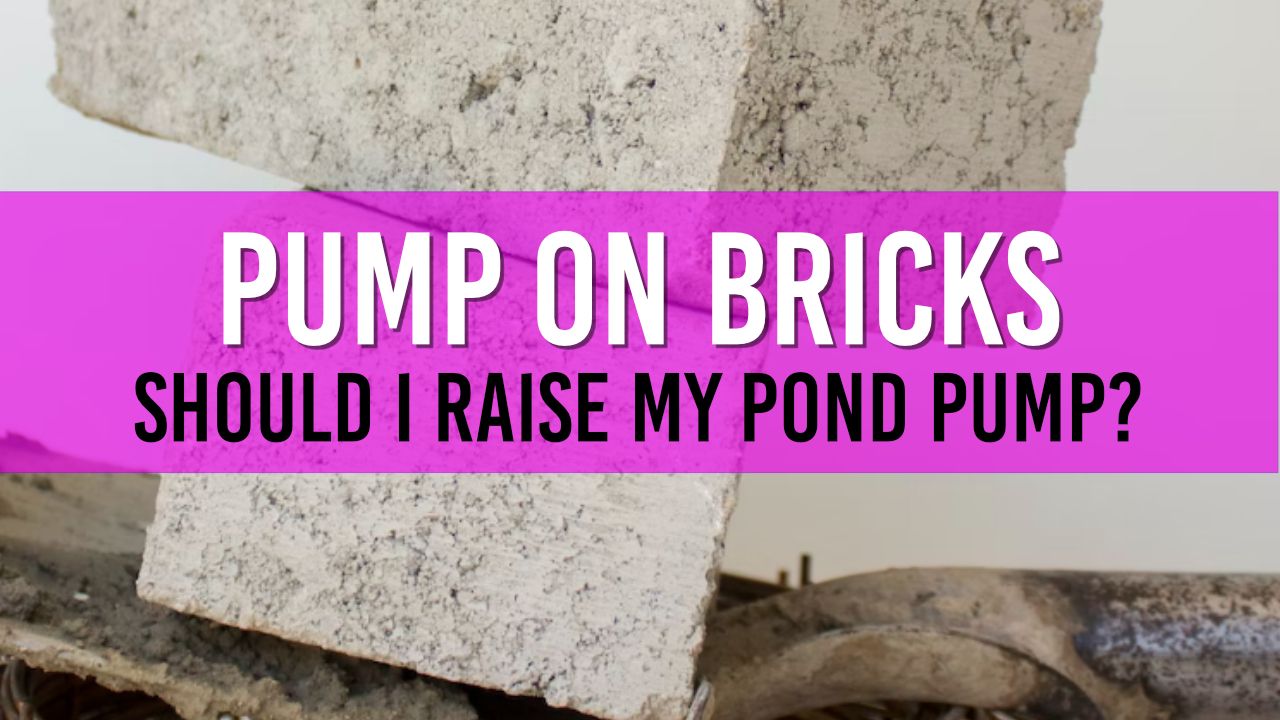Using Bricks to Raise Your Pond Pump
Placing your pond pump on bricks helps prevent your pump being clogged with silt and sludge ensuring it runs for longer between cleans.

Table of Contents
A question that gets asked by many pond owners old and new is “Should I put my pond pump on bricks“, and “Why?”. In this article, I will go through the reasons why pond owners choose a raised pond pump over placing the pump directly on the liner. I discuss what benefits you get for doing so and if you really need to use bricks – or can you use something else.
In this article, I also cover the myth surrounding raising your pond pump, why you should do it, and what to look out for when raising your pond pump using bricks (or anything that increases its height).
Quick Reference Guide
| Category | Details |
|---|---|
| Key Benefits | - Extends pump lifespan |
| - Enhances water circulation | |
| - Reduces debris intake | |
| - Provides stability | |
| Materials Needed | - Bricks |
| - Pond pump | |
| - Measuring tape | |
| Steps Involved | 1. Measure the base of the pond pump. |
| 2. Choose appropriate-sized bricks. | |
| 3. Place bricks at the desired spot in the pond. | |
| 4. Position the pond pump on top of the bricks. | |
| 5. Ensure stability and proper alignment. | |
| Additional Tips | - Regularly check bricks for wear or shifting. |
| - Clean the area around bricks to prevent silt buildup. | |
| - Ensure the pump's power cord is safely placed away from water. | |
| Estimated Time | 20-30 minutes |

WHY PLACE YOUR POND PUMP ON BRICKS – IS IT A GIANT MYTH?
In many of the pond supply brochures you receive through the post, it’s always mentioned where you should place your pond during the summer and winter months. However, they never seem to mention if your pond pump should be elevated off the floor of your pond.
It’s a well-known fact that during the summer months, your pond pump should be in the higher areas of your pond, and in the winter in the deeper areas of your pond – but can you improve the height of your pump to increase efficiency and water flow?
Any long-term pond owner will always resent the days when they need to turn off the electricity supplying their pond to perform a full filter sponge clean. They soon realised that the reason their waterfall was slow, or the water started to smell was down to the amount of silt that was being sucked up by the pond pump and therefore blocking the filter media and pond pipes.

Pond owners found that raising their pond pump off the floor using bricks not only allowed more water to surround the cage, but they did not need to perform pond maintenance as often compared to when the pump sat directly in the pond silt/sludge.
When I built my first pond, I placed the pond pump directly on the pond liner, and it ran flawlessly for several months without any issues. The problems started to arise just after autumn when I not only added fish but leaves/debris that sank to the bottom of the pond and started clogging my pump – anybody tackling pond water in cold weather knows this is not the most enjoyable thing.
Will a raised pond pump damage my filters, pipes or liner?

When placing your water pump on bricks you should actually notice your pond water flow is improved, but at what cost? From my own experience raising my pump resulted in no damage to my filter boxes or pipework.
With older worn pond liners care should be taken when lowering the bricks into your pond to avoid any tearing or ripping. The same care should be applied when moving your pond pump for cleaning – do not drag the pump as this may cause the sharp corners of your bricks to rip your pond liner (a very expensive mistake).
If your pond pipes are old and have weak joints, you may find that the increased water flow from your raised pond pump will put pressure on seals and joints – but nothing that can’t be fixed with new pond pipe / PTFE tape.
Shouldn’t my pond pump be sucking up silt?
Pond pumps should not be sucking up silt, leave that for the pond vacs. If you check indoor aquariums, none of their pump intakes sit directly on the base of the tank – they are either halfway or 3/4 to the base.

Silt will quickly block your pond filter cage and impeller putting more strain on the pump and your electrics. Pond silt is also very good for grazer fish like Koi & Goldfish who will often spend their days sucking silt, giving it a chomp and spitting it back out.
Pond pumps for any water feature/filter should be constantly cycling water to remove harmful nitrates, so any silt that is blocking your pond pipes will start to pollute your pond water with harmful ammonia.
Gravel-based ponds will not have “as much” silt at the bottom, but I really see no harm in altering your pump position for maximum efficiency.
Do I need to use special bricks for raising my pond pump?
I’ve spoken about bricks an awful lot in this article, however you are not really forced to use them when raising your pond pump. I personally use bricks because they are:
- Cheap
- Heavy
- Perfectly sized for my pond pump
Bricks are cheap, and most gardens often have a few bricks laying around that you can use to raise your pond pump. Their weight means they will sink and will not be moved easily by grazing koi whilst providing solid stability for the heavy pond pump.
For my pump with cage, 2x bricks are the perfect size for the pump to sit on which allows the maximum amount of water to encompass my pump cage.
If you do not fancy placing bricks into your pond, choose something that is fairly heavy (to provide stability) and that will not break down / deteriorate in your pond water.
How to add bricks to your pond
If after reading this article you feel compelled to place your pond pump on bricks, then the process is incredibly simple to follow. One thing worth noting is I always prefer to put my bricks into a corner of my pond – or at least flush up to one side.
In the past I did try to have my raised pond pump away from the liner walls, however, my large Koi were quite adamant about pushing the pump off.
If the base of your pond is currently covered with gravel, I suggest slowly sweeping that to the side for the bricks to sit flat on the liner (rather than directly on the gravel). After the bricks have been laid, push the gravel up to the edges of the bricks for a nice-looking finish.
Instructions to alter your pond pump position
- Clean the bricks thoroughly using water
- Decide on a position in your pond (as above – keep it close to a wall)
- Slowly lower each pond brick until it’s on the base of your pond
- Move the pond pump and slowly lower it onto the new bricks.
If you are double layering your bricks, rotate each row of bricks 90 degrees for increased stability.
What happens if I don’t raise my pond pump on bricks?
A pond pump's job is to suck water and pass it to your filter box, it’s as simple as that. It doesn’t matter if you have a singing all-dancing pond pump or a cheap £10 pond pump – the role of the pump is the same.
Leaves, fish waste and other debris over time will sink to the bottom of your pond and will create “silt”. Generally, your pond pump will pick small pieces of debris up as it fall and pass through to your filter box therefore removing the debris.
Depending on the placement of your pond pump in your pond, it’s not always possible for all pieces of debris to be sucked up by the pump and over time will collect on the pond liner where it becomes thicker, heavier and more difficult to pass through your pond pipe system.
Placing your pond pump directly on the base of your pond will cause your pump to become clogged very quickly and ultimately blocked.
In Conclusion
Placing your pond pump on bricks will reduce the amount of silt and mud your pump picks up. Most liner-based ponds will have a layer of harmless silt at the bottom, so placing your pond on a couple of bricks will ensure your pump will not get clogged as often.
Changing my pond pump position using nothing more than block paving bricks not only reduced the amount of times I needed to clean my pump cage but keeps my waterfall running for much longer without maintenance.
As with all pond myths, you need to try it to see if it works for you, let me know!

